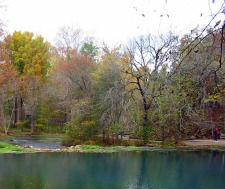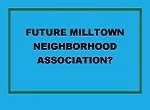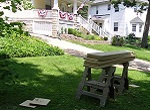Cleaning Up Your Neighborhood Park Is A Simple, Rewarding Activity
Last Updated: June 23, 2025
To prepare for cleaning up your neighborhood park, you must plan to have the right equipment available. You also need to have enough volunteers and an easily understood game plan, so that your workers can arrive at 8 or 8:30 a.m. on a Saturday morning and finish before lunch. We provide details for pre-planning, day of the event, and post-event debriefing below.
Cleaning up your neighborhood park is a great project for new and experienced neighborhood associations alike. Block clubs, high school organizations, and church groups also might find this to be a helpful and meaningful activity.
Why Choose a Park Clean-Up?

We highly recommend cleaning up your neighborhood park as a first project for a new neighborhood association or merely a group that would like to become more active in their community. The time commitment for each individual except the organizer is minor. Volunteers can see the results within a couple of hours, and the entire community enjoys and comments on the success for a few days. The beauty of this activity is that it can recur year after year, and managing the event becomes easier every time.
More experienced organizations will recognize that this quick win is a great way to engage new people in community work, and that the active outdoorsy element of the project attracts people who do not want to sit in meetings.
Another major advantage to this type of project is that it is easy to incorporate children and youth; at age 3 and up, they can pick up trash. Teenagers can be drawn in, especially if you provide a good-looking T-shirt that passes their fashion test. Teens and pre-teens will be especially adept at sharing your cleanup on social media too, which is a real plus for your neighborhood association or informal group.
Try to attract several young muscular volunteers. Cleaning up your neighborhood park is ideally suited to getting teenagers and young adults excited about community work, and their energy is a real bonus in comparison with the middle-aged and senior population who fuel many of the other neighborhood association or block unit activities. This is a terrific project for grandparents and grandchildren to share, by the way.
Planning the Cleaning Day: What to Do in Advance
First and foremost, begin to recruit volunteers. Having a very rough idea of how many volunteers you will have helps you make wise decisions about priorities. To boost recruiting, take photos of any problematic area of your target park.
Remember that people attract people, so you will want to provide a way for people who plan to attend to identify one another on social media. Design an attractive graphic, and let your social media chair or anyone in your group that uses the media blast out the news several times. There are any number of platforms suitable for this.
Then for inspiration, if you are trying park clean-up for the first time, you may want to circulate an inspirational video about the value of parks, such as the National Recreation and Parks Association's The Power of Parks.
If you have several parks or your chosen location is large, decide on priorities for cleaning up your neighborhood park. It would be better to finish in an hour and a half and give everyone an opportunity to socialize than to tackle a much too ambitious project and leave people feeling unsuccessful at the end of the morning.
Approach your town or city government to see if they can remove the trash. After all, the government that owns the park should keep it spotless, but the reality of tight budgets is what makes cleaning up your neighborhood park a citizen imperative in many towns and neighborhoods.
If your solid waste collector is a private company, you may need to ask the company directly. Often they will be helpful, especially if they receive positive publicity in the community. If you need to give them a big banner along the road or at the check-in point, it will be a small price to pay. Dumpster fees at market rates can be hefty, so if you strike out with your local government or homeowner's association, don't leave this detail until the last minute.
Most local governments will be surprised at your interest in cleaning up your neighborhood park and happy to assist. If not, then your first concern must be where and how you will dispose of what you collect. In most instances, you will be astounded at how much trash there is.
Incidentally, a side benefit of such a work day is that the planning of it represents a great opportunity to build a rapport with the parks director or other high-level executive of the parks department. You can accurately assure such employees that if they become interested in and involved with community activities and organizations, such as yours, they will find increased support for parks when budget time comes.
Plan for as much recycling and waste reduction as possible. After your group becomes expert at planning and executing the semi-annual clean up, consider asking a group of artists to attend to pick up items that can serve as found objects in artwork.
If there are no recycling containers ordinarily found in the park, but your town distributes them to residents or businesses, see if they can be temporarily stationed at your park. Our experience has been that you need to request twice as many containers as the city originally thinks you will need.
Publicize this event to the community at large, unless you intend this to be a committee project. Even then, consider inviting other neighbors, in order to build buy-in for cleaning up your neighborhood park on a periodic basis.
If you have a neighborhood newsletter, publicize the clean-up well in advance. Be sure to mention this event in your social media as often as appropriate within the framework of your organization's policy.
By the way if you have no social media accounts but have been intending to establish some, the cleanup is a wonderful way to begin. Typically these events give you opportunities to capture some wonderful photos and videos that will attract attention later on your chosen platform.
Think of an intriguing event name if you can. Clean, Green, Lean, and Mean is more exciting than Spring Clean-Up. If you can come up with a logo or graphic image that can be used in your social media, that would be great. If nothing else, at least make an eye-catching green box and place the name of your event inside it. In smaller towns, your local newspaper may give you plenty of free publicity, but in larger cities, don't count on anything of the sort.
Advise volunteers to bring their own work gloves. In case they don't, we always bring some extras to have on hand. Sanitation and safety are concerns, and even though many park systems don't allow glass containers, they seem to sneak in and get broken there anyway.
Figure out how to provide water, if there are no fountains in the park. It's greener to bring some large coolers instead of buying individual plastic bottles of water. However, in large parks, you may have to give out individual bottles.
If the weather might be cold, think about whether you want to offer coffee and hot chocolate to keep your volunteers around longer. You can always have some fruit or pastries if you want to reward your workers.
Paved areas, such as sidewalks, trails, plazas, or tennis or basketball courts, will require some push brooms. Again, your municipality may be a good source of some tools that can be borrowed. In a pinch, though, we have found that a household broom is better than nothing.
If you intend to trim shrubbery or trees, of course you will need appropriate tools. Rakes are helpful in some situations.
If the park includes a stream, you will want to advise people to wear boots if they have them. Then a few people can get in the stream itself, if conditions are appropriate.
If you plan to clean restrooms, specialized cleansers and extra latex gloves will need to be gathered. Request that the park owner provide you with additional supplies so that your clean restroom actually will have toilet paper at the end of your work day.
Since we are revising this page during the coronavirus pandemic, it is timely to reiterate that you should be quite mindful of any current public health risks in your community. It is not at all unusual for volunteers to find used needles, animal and sometimes human waste, and other germ-laden items in the park.
Be aware that if you intend to tackle graffiti, you will need some specialized advice on how to remove it. Your local hardware store may have some ideas. Large cities may have graffiti removal teams. But often graffiti is best tackled by simply painting over it.
Think ahead about actual conditions in the park. Let's hope you never are in the situation where you may find broken glass on a playground, but one of this website's authors did just that. People had to be sent home to find sifters, colanders, screens, strainers, and whatever else came to mind to try to get glass out of the sand.
If your parks department will trust you to repaint color contrast on bollards, steps, or other hazards, be sure to have the right colors of paint on hand. You might even be engaged to paint other items, such as wooden restroom buildings or see-saws.
Have a few minor first aid supplies at the event, and of course bring cell phones in case of any injuries of consequence. Advise all participants of the number they should call if injured; consider using a phone other than that of the main organizer of the event. Discuss insurance and liability with the local government or homeowners association. You probably will have to ask folks to sign a waiver of liability for injuries.
At the Park Clean-Up
Greet each volunteer warmly and put them to work very quickly. The longer people have to wait to be shown where things are and what should be done, the more awkward and apprehensive they become.
Explain to each person clearly where the trash collected is to be placed, and remind him or her not to create more litter while sampling the refreshments. Caution people to be careful with glass and metal.
Often people seem more comfortable working in pairs, and if the area feels at all remote or dangerous, actively encourage this pairing off. Sometimes team formation may be helpful, especially in larger parks.
Remember to take photos of all the collected trash and to focus in on any unusual items. If all the trash will be placed in dumpsters or bags as you progress, you may have to take several photography tours to capture your results.
At a park clean up I helped to staff, we got photos of rabbits, squirrels, birds, curious and cute dogs on leashes, and even a beaver. These two can help those who miss out on the fun realize that actually next year's event might be a pleasant morning out of the house.
Respect all volunteer efforts, and try not to criticize the results. In a park, if people spend more time joking around than working, you have to respect that too. Chances are that any trash removal or any attempt at trimming or cleaning will be an improvement.
Explaining the Benefits of Cleaning Up Your Neighborhood Park
As you notice people taking a momentary break, engage them in a conversation about why it's important to keep the park tidy. If you have a respected elder who comes to assist with cleaning up the neighborhood park, but you notice that he or she can't really keep up the pace, this task might be partially delegated to them.
Remind volunteers that all types of users should be able to enjoy the benefits of cleaning up your neighborhood park. But also explain that this event is a symbol of the neighborhood's determination to maintain high standards in every way.
A park is public space, and cooperating to take care of something
that belongs to all of us is a way for people in the community to meet
each other and start new friendships. It also builds community spirit.
As people leave, thank them profusely for their efforts. If your organization has any nice give-away items, this would be the time to give volunteers a token gift. If you plan for future events that include cleaning up your neighborhood park, mention it at this time. Try to build a mailing list of people who are especially interested in this activity; email works best in most communities. Encourage them to talk to others about the park and to talk with children about the importance of cleaning up the neighborhood park on a regular basis.
After the Neighborhood Event
Return borrowed equipment, clean up after the clean-up crew, and if any town or city employees are present, be sure to thank them again. They may have sacrificed a bit for your event as well, sometimes working on a Saturday when they wouldn't ordinarily. Make sure that all solid waste is placed where you were told to put it.
If you have good quality photographs, post them on social media early and often. Try sending them to your local press too. If you anticipate an annual event, make sure to blanket your television stations with photos and video, and tell them about your future plans.
I like the picnic lunch finale for cleaning up your neighborhood park, but certainly you can dispense with that if you can't afford it, if there is no place for hand-washing in advance, if you sense that people can't spare the time, or if your work crew is likely to be tired and cranky at the end of the clean-up.
Lastly, if this is an autumn event, start planning your spring clean-up as you disperse, or vice versa. Almost any viable neighborhood group can manage this twice a year.
But don't overdo it. That's why I encourage a morning-only event. Weekends are so busy in most households that you will be much more successful than if you request a whole day's work.
So get started with the planning. This is an easy event compared with many others, providing your town or solid waste company does the heavy lifting of carrying away what your volunteers pick up.
When Your Park Has a More Difficult Problem
This page does not address problems of drug use or sales, violence, prostitution, or petty thefts in parks. If you have those issues, you will need to see the safe parks page or the Crime Prevention section in the navigation for this site.
We should mention too that if your local community park has a major problem with littering or overgrown vegetation, you may have to repeat the cleanup weekly, every other week, monthly, or twice a year to get things under control. Be encouraged that both research and our experience show that littering decreases as a space becomes more tended. You should be able to decrease the frequency of cleanup events in the future. Repeated cleaning when needed also will help with those more severe problems of criminal activity in the park, if need be.
Learn More About Neighborhood Topics
- Making and Keeping a Good Community >
- Community Beautification > Cleaning Up Your Neighborhood Park
Join GOOD COMMUNITY PLUS, which provides you monthly with short features or tips about timely topics for neighborhoods, towns and cities, community organizations, and rural or small town environments. Unsubscribe any time. Give it a try.




